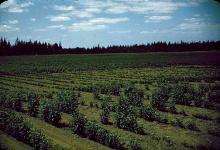Cause Pratylenchus penetrans and P. vulnus. Root-lesion nematodes are migratory endoparasites where part of the population is in soil and part in roots at all times. Root-lesion nematode infection does not usually cause specific symptoms as damage is associated with high nematode numbers in the soil, decreasing root function and root death.
Symptoms Poor growth and off-color, usually in spots in the orchard. Roots are brown or black and decayed or have dark lesions.
Sampling If plants are present, always include soil and roots in samples sent for nematode analysis. Take samples any time if the numbers are interpreted in relation to nematode population dynamics. In most crops, populations are relatively low through winter and spring but increase rapidly through summer. It is best to take samples in late summer to test for nematodes in fields that are going to be planted to cherries.
Replicated studies have shown that damage may result at 80 nematodes per 100g of soil. Local soil types, climate, moisture, and other factors vary widely where damage could occur at different nematode densities.
Cultural control
- Avoid sites with high soil populations of root-lesion nematodes.
Chemical control
- Soil fumigation effectively reduces populations of these nematodes in soil. They may build back up quickly, but fumigation still helps young trees establish.
- Basamid G. Avoid application when soil is over 90°F. Do not apply within 3 to 4 feet of growing plants or closer than the drip line of larger plants. Do not harvest within one year of application. 5-day reentry. Restricted-use pesticide.
- Dominus at 10 to 40 gal/A. Apply as a shank injection to an entire field or raised beds when soil temperatures are above 60°F but not greater than 90°F. 5-day reentry.
- Telone II at 27 to 35 gal/A broadcast, or 24 fl oz for a single tree planting site delivered 5 ft deep. 5-day reentry. Restricted-use pesticide.
- Salibro at 30.7 to 61.4 fl oz/A can be used AT planting for non-bearing trees. May be applied using drip or micro-sprinkler irrigation, drench or soil spray followed by irrigation. Group N-UN nematicide. 12-hr reentry.
- Velum Prime at 6.5 to 6.84 fl oz/A can be used after planting using drip, trickle of micro-sprinklers. May be applied day of harvest. Group 7 fungicide. 12-hr reentry.
Biological control
- MeloCon WG (Paecilomyces lilacinus strain 251) at 2 to 4 lb/A plus a soil wetting agent can be applied to established plants, although it might be better used when applied to plants just before planting. Stable for only days at room temperature, weeks in the refrigerator or for a year if frozen. Unknown efficacy in the PNW. 4-hr reentry. O
Reference Clavero-Camacho, I., Cantalapiedra-Navarrete, C., Archidona-Yuste, A., Castillo, P. and Palomares-Rius, J.E. 2022. Distribution, ecological factors, molecular diversity, and specific PCR for major species of pin nematodes (Paratylenchus spp.) in Prunus plantations in Spain. Plant Disease. 106:2711-2721.


